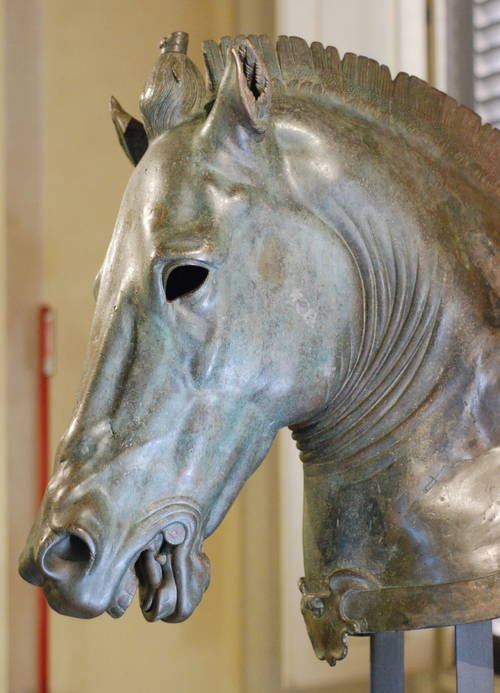
It is well known that the famous Medici and Lorraine collections are housed in various museums in Florence, not just in the Uffizi and Pitti galleries (recently re-united under one director). The scientific collections are in the Museo Galileo, the musical instruments in the Galleria dell’Accademia, the Renaissance sculpture in the Bargello, the wax models in the Museo della Specola, etc., and the archeological material in the Museo Archeologico. But it is also a fact that all these ‘satellite’ museums are usually overlooked by visitors to the city, since it is the paintings that everyone seems to want to see (or at least that is what they are told by the tourist agencies).
It is therefore rare to encounter more than a handful of visitors in the Archaeological Museum (except when school parties are taken there). In fact throughout the many decades since the Arno Flood of 1966, when the entire ‘Museo Topografico’ of Etruscan finds from Tuscany was destroyed, it has had a rather neglected feel. But the exciting news is that with its new Director Mario Iozzo, under the umbrella of the ‘Polo Museale Toscana’, which since 2015 has been in the capable hands of Dr Stefano Casciu, the Museum has suddenly been spruced up and work is underway to open more exhibition space so that the works in the deposits can at last be seen.
Throughout the museum the display has begun to be renovated, with new stands for the pottery (and in some cases slowly moving circular bases so that you can stand still to see all the painted sides of certain vases). The garden, visible from many of the windows, is now beautifully kept with the fountain working again (but sadly still only open on Saturday mornings). The corridor with the Medici collection of precious antique gems and cameos is not yet regularly on view.
While work is going on, however (until March 2019), visitors can see a delightful exhibition, “The Art of Giving”, in the first hall. It documents recent donations including a huge collection of beautiful ceramics from burial sites and sanctuaries on the Ionian coast of southern Italy (the area known in antiquity as Magna Graecia). Many of the vases have scenes where the protagonists are exchanging gifts, making the title of the exhibition doubly meaningful. There is also a ceramic cup dating from the 6th century BC which has been recomposed using the missing piece which had found its way to the Akademisches Kunstmuseum in Bonn (in exchange, a fragment of another vase was given to the Bonn Museum so that it, too, could be reunited with the fragments they own). There are also some Roman marbles on view which have recently entered the collection (the sarcophagus with pairs of griffins between incense-burners is especially interesting).
In the permanent collection, the first room on the first floor is now used to exhibit the sensational Mater Matuta, an Etruscan masterpiece (c. 450 BC) showing a seated female god with a child on her lap. This is one of the treasures of the museum but has not been on show for decades. The famous bronze Chimera also has a room to itself, shared with a very beautiful bronze head of a youth found in Fiesole.
The Minerva, on the floor above, is now displayed without her right arm since it has been proved to have been an addition made by Francesco Carradori in 1784-5 in a mistaken restoration (the ‘modern’ arm is displayed close by, together with a cast of the statue as restored in the 18th century). The wonderful Arringatore is currently on exhibition in Karlsruhe but will be back here on 17th June. The bronze Horse’s Head (which belonged to Lorenzo the Magnificent and was restored in 2015) and the Roman portrait bronzes are all on show (in the past these were often in rooms kept locked). The famous François Vase, a huge Attic krater, has been given a room of its own with multi-media touch screens explaining all the details. The famous incident when a frustrated custodian seized his stool and smashed it is recorded by the presence of the stool itself (the vase was thankfully able to be restored, piece by piece). And for the first time, two more pieces of exquisite Attic pottery are displayed nearby, suggesting that they might have been part of the original hoard of artefacts found in the same tomb, placed there to accompany the deceased on his way to the underworld.
Further innovations are the scale model of the Chimaera at the entrance which can be felt by the visually impaired and stroked by young visitors, and a showcase before the ticket office displaying just three exquisite examples of the museum’s holdings to whet visitors’ appetites. One comes away with the feeling that at last the Museum is being well looked after and that there will be many exciting new developments there in the near future.
In this Florentine season of what has been termed ‘overtourism’, a visit to this Museum is highly recommended not only for the treasures it contains, but also for its peaceful atmosphere.
by Alta Macadam, author of Blue Guide Florence.







Another great development at the Archaeological Museum is that all the object labels and wall texts in the “Art of Giving” — as well as in the newly renovated François Vase, Amazon Sarcophagus, and small bronzes galleries — are bilingual, Italian and English. The multimedia touch screens are bilingual, too!
Thank you!